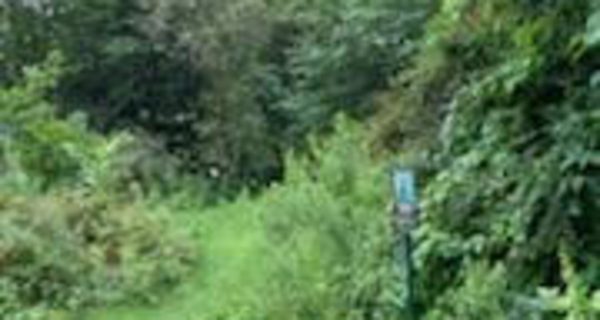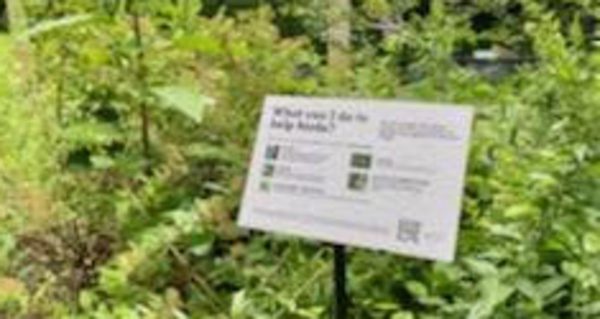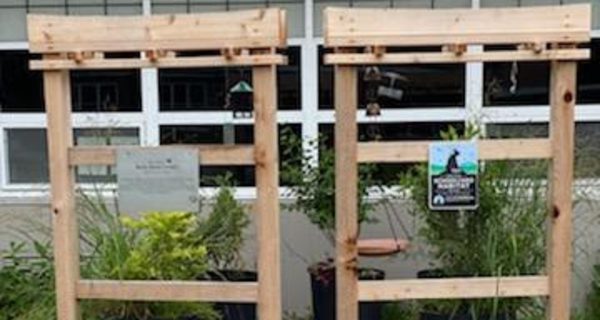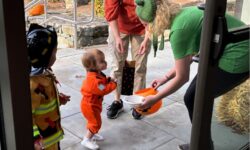So the third graders facing the pavement could see birds as well, Vitale and Dorothea Von Herder worked together to create a bird sanctuary dedicated to longtime Pine Hill teacher Mary Lucey.
By James Kinneen
Hometown Weekly Reporter
Unless you were once a third grader at Pine Hill Elementary School, or have kids who attend that school and thus may have been around it after school hours, you probably don’t know there is a bird observation garden on school grounds that's open to the public.
And even if you do know about the garden, you almost definitely don't know the history behind it.
Though it has lost some of its shine, the Michael Lisnow Bird Garden & Outdoor Classroom has long remained one of Sherborn’s hidden jewels, with its obscurity in large part thanks to what has happened to the site over the years. But with the help of Sherborn Sustainability Coordinator Dorothea Von Herder, Pine Hill Community School Association Garden and Outdoor Classroom Coordinator Julie Vitale is working to return the site to its former glory - and see it live up to the promise it held when first constructed 21 years ago.
Essentially, in 1999, a Boggestown Garden Club member heard about another school’s bird observation garden and asked Principal David Nihill if he’d be interested in having one at Pine Hill. He said yes, so she raised the funds through the Sawin Fund and found a garden designer named David Schworer who was willing to design and install it for free. In October 2000, the garden, which was full of native plants and shrubbery aimed at attracting local wildlife, was formally dedicated to Michael Lisnow, the first student with multiple disabilities to attend Pine Hill, who died as a ten-year-old in 1996.
Unfortunately, because there was not adequate discussion of the project’s long-term oversight, issues quickly arose regarding who would be responsible for maintaining the space. As a result, although third-graders have continued to use the garden for classes, other than town workers mowing the area, there has been no maintenance of the garden for over 15 years. Once a well maintained bird sanctuary, the area has become overgrown with invasive plants like oriental bittersweet and buckthorn.

However, after the Pine Hill CSA Board created the position of Pine Hill CSA Garden and Outdoor Classroom Coordinator and elected Julie Vitale to it, she looked around to see “what we have at our school as we try to expand and develop our campus.” Discovering the bird garden, Vitale “thought, 'Wow, this is a real gem up here that’s kind of been forgotten, other than the third grade teachers taking their students up there.' That’s when we started figuring out the history of the project and why it is where it is now.”
Reaching out to one of the original garden club members, Vitale discovered photos of the garden in its best years, and realized that what is now a lawn path used to be gravel. Having seen it in the best of times, Vitale knew she was not going to have the funds or manpower to fully return it to what it once looked like.
However, she believes that level of a manicured garden isn’t necessary for an ecological garden, and pointed out how the garden could be more sustainable than it was in the early 2000s. She also understood that while the Boggestown Garden Club was happy someone was going to renovate the garden, the members didn’t have the resources to take over the project themselves.

Instead, with no parent volunteers allowed to come to Pine Hill due to COVID, Vitale reached out to high school kids looking to fill their community service hours, then invited them to pull invasive species and clean the area in April. Post-pandemic, however, she will be able to have parents and students interacting with each other, so she is planning to have a fall and spring cleanup with parent volunteers. But while the space is currently maintained well enough for visitors to drop by when school is not in session, Vitale sees much more work to be done.
“Like any garden, it requires continual care and maintenance. The care and maintenance will be continual, it will just be part of what we do in the community. We’ve included QR codes so visitors can scan the code and learn more about the teaching topic we have on that sign. But it will take another two to three years to fully complete the interpretation of the space.”
But after discovering that some third grade classrooms could easily view the birds while others were stuck looking at pavement, Vitale looked to Dorothea Von Herder for help. Looking to make a bird sanctuary for those students who didn't have the luxury of a view of the Lisnow Bird Garden, Von Herder helped win a $1,000 grant with the Grinspoon Foundation to develop another, smaller bird sanctuary, consisting of a little space that’s all containerized using recycled rubber pots and bird-attracting native plants, a bird bath and bird feeders. That area is dedicated to third grade teacher and bird advocate Mary Lucey, who taught at Pine Hill for over 30 years.
As to why Vitale was so willing to put in all this effort when those who put in so much of the initial effort were content to let the space become overgrown, she noted that above all else, she wanted students who have so little agency in terms of their carbon-footprint-making decisions to know what it was like to do something about climate change.
“For me, a huge thing was how do we help our kids understand climate change and take action now today within the scope of what kids are able today. They’re not going to buy electric cars or heat pumps for their home, but they can plant plants and they can allow sections of their lawn to kind of go re-wild, and add a few native plants in. It’s really empowering for them. That’s one of the things I noticed most was the students being like, 'Wow, I’m doing something that’s meaningful in the face of climate change and building climate resilience right here at my school, and that really resonated with me.'”























